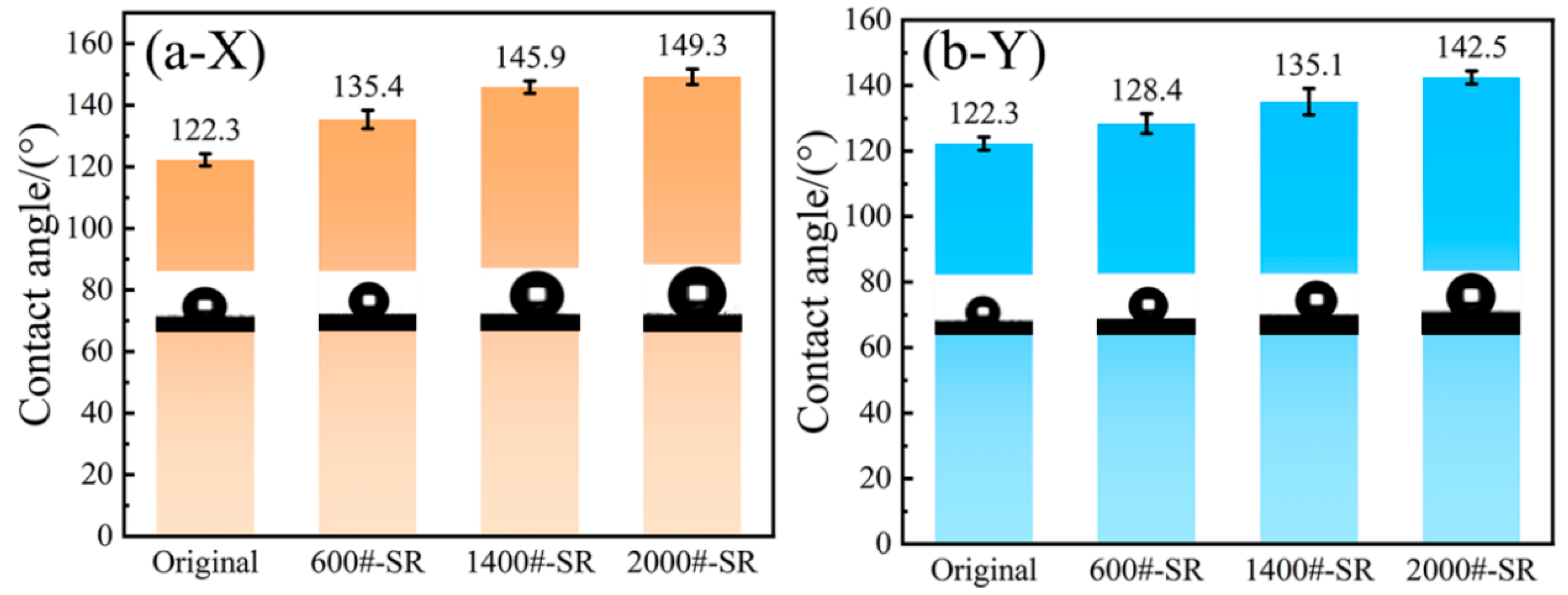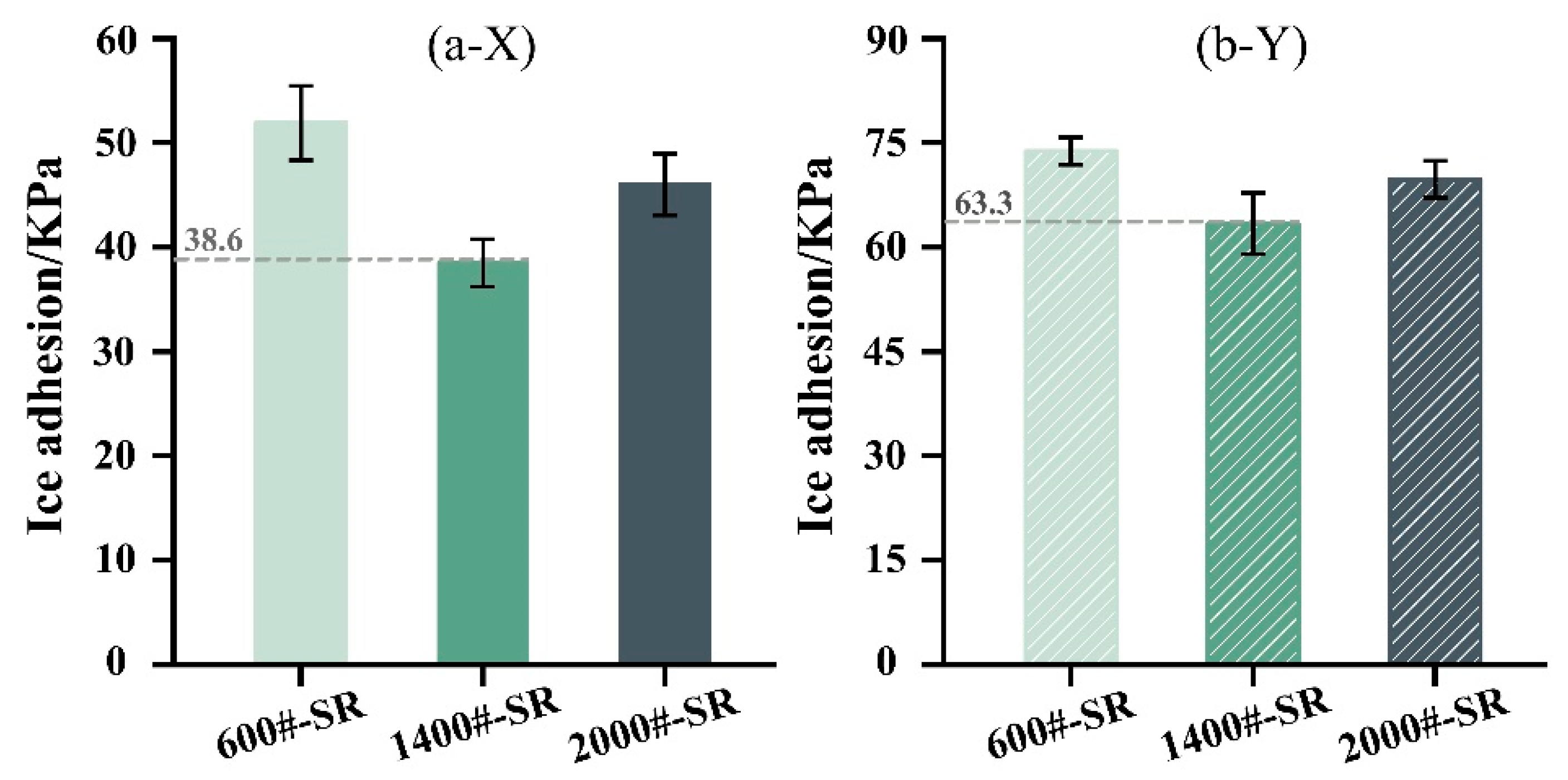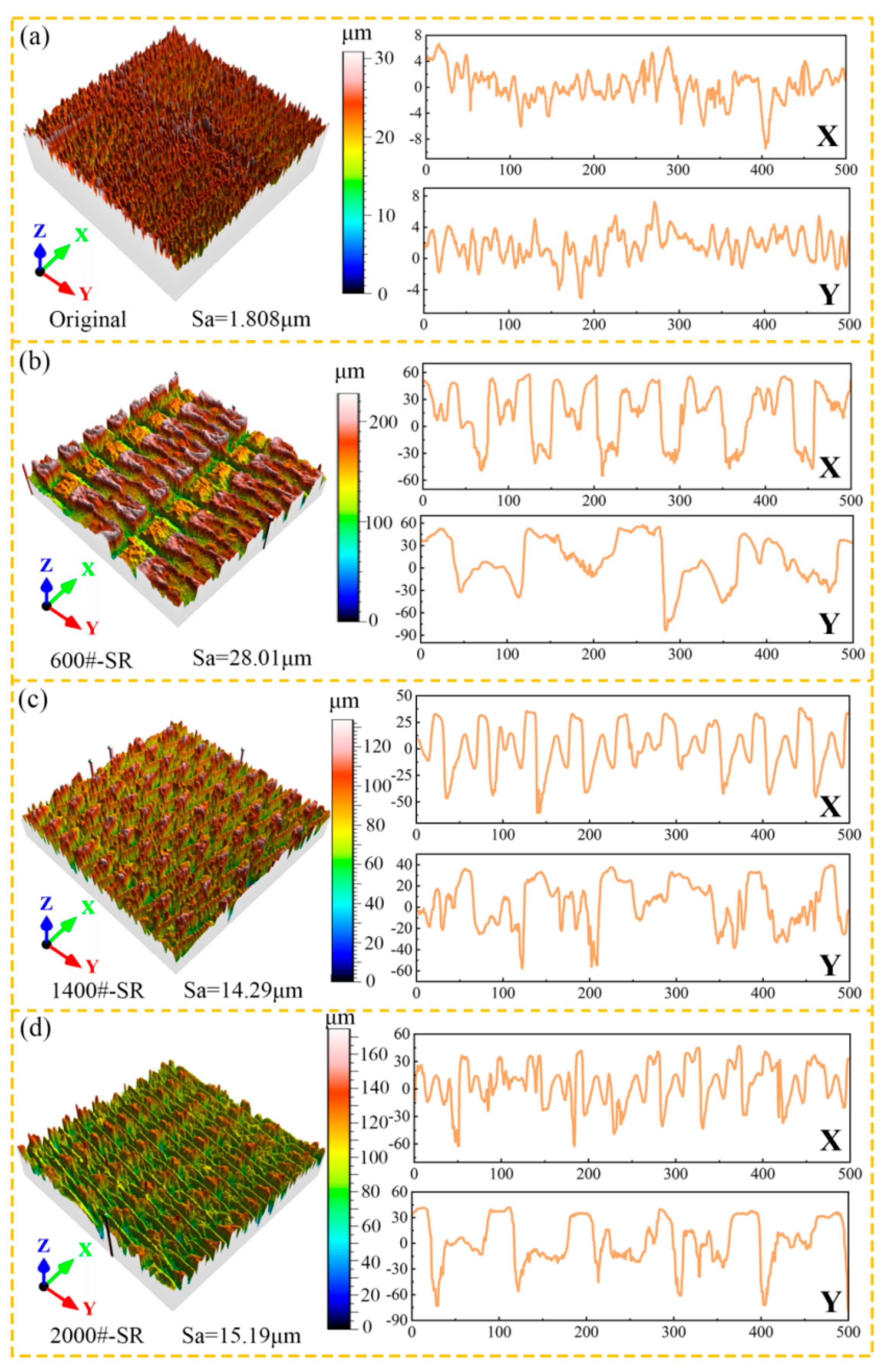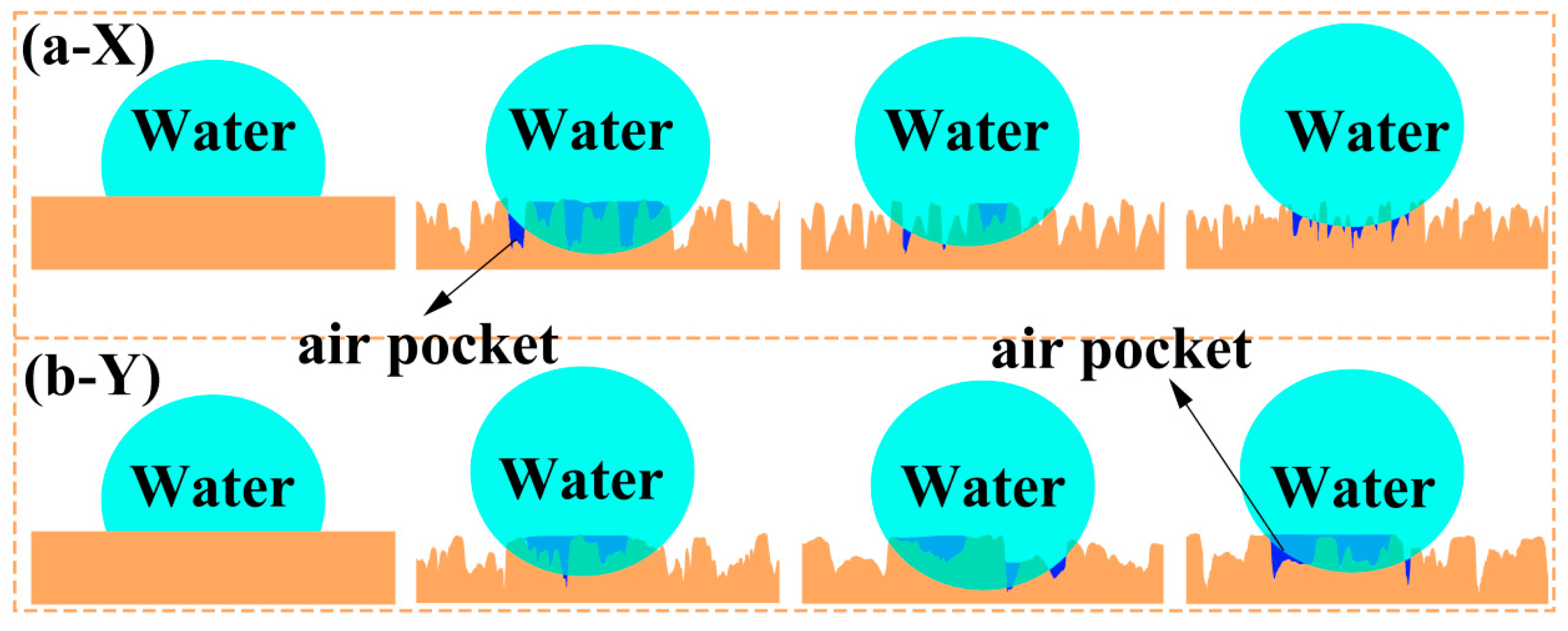The Influence of Anisotropic Microstructures on the Ice Adhesion Performance of Rubber Surfaces
Abstract
1. Introduction
2. Materials and Methods
2.1. Materials
2.2. Preparation of Hydrophobic Silicone Rubber
2.3. Ice Adhesion Strength Testing
2.4. Wettability
2.5. Morphology
3. Results and Discussion
3.1. Structural Characterisation of M-SR Composites
3.2. Anisotropic Wetting Properties of M-SR Composites
3.3. Ice Adhesion Properties of Anisotropy of M-SR Composite
3.4. Mechanism Analysis of M-SR Composite Surface
3.4.1. Surface Microstructure Morphology
3.4.2. Surface Wetting Mechanism
3.4.3. Ice Adhesion Performance
4. Conclusions
Author Contributions
Funding
Institutional Review Board Statement
Informed Consent Statement
Data Availability Statement
Conflicts of Interest
References
- Wang, F.; Zhuo, Y.; He, Z.; Xiao, S.; He, J.; Zhang, Z. Dynamic Anti-Icing Surfaces (DAIS). Adv. Sci. 2021, 8, e2101163. [Google Scholar] [CrossRef]
- He, Q.; Li, K.; Xu, Z.; Wang, J.; Wang, X.; Li, A. Research progress on the construction strategy and technical evaluation of the aircraft icing accretion protection system. Chin. J. Aeronaut. 2023, 36, 1–23. [Google Scholar] [CrossRef]
- Zeng, D.; Li, Y.; Huan, D.J.; Liu, H.Q.; Luo, H.Y.; Cui, Y.X.; Zhu, C.L.; Wang, J.X. Robust epoxy-modified superhydrophobic coating for aircraft anti-icing systems. Colloids Surf. A-Physicochem. Eng. Asp. 2021, 628, 127377. [Google Scholar] [CrossRef]
- Kim, Y.; Yee, K. Target temperature-based simulation method for predicting performance and designing aircraft thermal anti-icing systems. Int. J. Heat Mass Transf. 2024, 229, 125688. [Google Scholar] [CrossRef]
- He, Q.; Jia, Y.; Wang, H.; He, J.; Wang, J.; Xu, Y.; Liu, Y.; Li, A. Triple conversion strategy to build anti-de-icing sheets for the leading edge of the rotor blade. Mater. Des. 2024, 237, 112516. [Google Scholar] [CrossRef]
- Jiang, S.; Diao, Y.; Yang, H. Recent advances of bio-inspired anti-icing surfaces. Adv. Colloid Interface Sci. 2022, 308, 102756. [Google Scholar] [CrossRef]
- Xuan, S.; Yin, H.; Li, G.; Zhang, Z.; Jiao, Y.; Liao, Z.; Li, J.; Liu, S.; Wang, Y.; Tang, C.; et al. Trifolium repens L.-Like Periodic Micronano Structured Superhydrophobic Surface with Ultralow Ice Adhesion for Efficient Anti-Icing/Deicing. ACS Nano 2023, 17, 21749–21760. [Google Scholar] [CrossRef]
- Yang, K.S.; Lin, K.H.; Tu, C.W.; He, Y.Z.; Wang, C.C. Experimental investigation of moist air condensation on hydrophilic, hydrophobic, superhydrophilic, and hybrid hydrophobic-hydrophilic surfaces. Int. J. Heat Mass Transf. 2017, 115, 1032–1041. [Google Scholar] [CrossRef]
- Mousavi, S.M.; Sotoudeh, F.; Chun, B.; Lee, B.J.; Karimi, N.; Faroughi, S.A. The potential for anti-icing wing and aircraft applications of mixed-wettability surfaces-A comprehensive review. Cold Reg. Sci. Technol. 2024, 217, 104042. [Google Scholar] [CrossRef]
- Liang, Z.; Geng, M.; Dong, B.; Zhao, L.; Wang, S. Transparent and robust SiO2/PDMS composite coatings with self-cleaning. Surf. Eng. 2020, 36, 643–650. [Google Scholar] [CrossRef]
- Alwazzan, M.; Egab, K.; Wang, P.T.; Shang, Z.Y.; Liang, X.H.; Khan, J.; Li, C. Condensation heat transfer on nickel tubes: The role of atomic layer deposition of nickel oxide. Int. J. Heat Mass Transf. 2019, 133, 487–493. [Google Scholar] [CrossRef]
- Wang, D.; Sun, Q.; Hokkanen, M.J.; Zhang, C.; Lin, F.Y.; Liu, Q.; Zhu, S.P.; Zhou, T.; Chang, Q.; He, B.; et al. Design of robust superhydrophobic surfaces. Nature 2020, 582, 55–59. [Google Scholar] [CrossRef]
- Lv, D.M.; Sheng, L.; Wan, J.P.; Dong, J.W.; Ouyang, H.S.; Jiao, H.P.; Liu, J.Q. Bioinspired hierarchically hairy particles for robust superhydrophobic coatings a droplet dynamic template method. Polym. Chem. 2019, 10, 331–335. [Google Scholar] [CrossRef]
- Xing, M.B.; Zhang, Z.T.; Wang, Z.Y.; Jing, D.L. Freezing process of water droplet on the cold plate surfaces with different wettability. Int. J. Heat Mass Transf. 2024, 230, 125773. [Google Scholar] [CrossRef]
- Memon, H.; De Focatiis, D.S.A.; Choi, K.S.; Hou, X.H. Durability enhancement of low ice adhesion polymeric coatings. Prog. Org. Coat. 2021, 151, 106033. [Google Scholar] [CrossRef]
- Xie, Q.; Hao, T.H.; Wang, C.; Kang, Z.H.; Shi, Z.H.; Zhang, J.F. The Mechanical Mechanism and Influencing Factors of Ice Adhesion Strength on Ice-Phobic Coating. J. Mar. Sci. Eng. 2021, 9, 315. [Google Scholar] [CrossRef]
- Stendardo, L.; Gastaldo, G.; Budinger, M.; Pommier-Budinger, V.; Tagliaro, I.; Ibáñez-Ibáñez, P.F.; Antonini, C. Reframing ice adhesion mechanisms on a solid surface. Appl. Surf. Sci. 2023, 641, 158462. [Google Scholar] [CrossRef]
- Wang, L.; Jiang, G.; Tian, Z.; Chen, C.; Hu, X.; Peng, R.; Zhang, H.; Fan, P.; Zhong, M. Superhydrophobic microstructures for better anti-icing performances: Open-cell or closed-cell? Mater. Horiz. 2023, 10, 209–220. [Google Scholar] [CrossRef]
- Shen, F.; Fang, W.Z.; Zhang, S.; Zhang, X.; Yang, C.; Tao, W.Q. Numerical simulations of freezing behaviors of water droplets impacting cold hydrophobic surfaces. Appl. Therm. Eng. 2025, 258, 124521. [Google Scholar] [CrossRef]
- Hou, W.Q.; Shen, Y.Z.; Tao, J.; Xu, Y.J.S.; Jiang, J.W.; Chen, H.F.; Jia, Z.F. Anti-icing performance of the superhydrophobic surface with micro-cubic array structures fabricated by plasma etching. Colloids Surf. A-Physicochem. Eng. Asp. 2020, 586, 124180. [Google Scholar] [CrossRef]
- Omidali, F.; Azizian, S.; Sohrabi, B.; Shabanlou, E.; Jaleh, B. Fabrication of highly-hydrophobic steel meshes using pulsed laser ablation and surface modification methods for oil/water separation. Surf. Interfaces 2025, 64, 106402. [Google Scholar] [CrossRef]
- Jiang, J.; Sheng, Q.; Tang, G.H.; Yang, M.Y.; Guo, L. Anti-icing propagation and icephobicity of slippery liquid-infused porous surface for condensation frosting. Int. J. Heat Mass Transf. 2022, 190, 122730. [Google Scholar] [CrossRef]
- Memon, H.; Liu, J.P.; De Focatiis, D.S.A.; Choi, K.S.; Hou, X.H. Intrinsic dependence of ice adhesion strength on surface roughness. Surf. Coat. Technol. 2020, 385, 125382. [Google Scholar] [CrossRef]
- Tong, W.; Xiong, D.S.; Wang, N.; Wu, Z.; Zhou, H.J. Mechanically robust superhydrophobic coating for aeronautical composite against ice accretion and ice adhesion. Compos. Part B-Eng. 2019, 176, 107267. [Google Scholar] [CrossRef]
- Pan, R.; Zhang, H.; Zhong, M. Triple-Scale Superhydrophobic Surface with Excellent Anti-Icing and Icephobic Performance via Ultrafast Laser Hybrid Fabrication. ACS Appl. Mater. Interfaces 2021, 13, 1743–1753. [Google Scholar] [CrossRef] [PubMed]
- Moon, C.H.; Yasmeen, S.; Park, K.; Gaiji, H.; Chung, C.; Kim, H.; Moon, H.S.; Choi, J.W.; Lee, H.B. Icephobic Coating through a Self-Formed Superhydrophobic Surface Using a Polymer and Microsized Particles. ACS Appl. Mater. Interfaces 2022, 14, 3334–3343. [Google Scholar] [CrossRef]
- Yang, Q.; Au, S.; Dijvejin, Z.A.; Zarasvand, K.A.; Dolatabadi, A.; Golovin, K. Superhydrophobic Surfaces Exhibiting Low Interfacial Toughness with Ice. Chem. Eng. J. 2025, 508, 160929. [Google Scholar] [CrossRef]
- Liu, Y.; Zhang, H.; Wang, P.; He, Z.Y.; Dong, G.N. 3D-printed bionic superhydrophobic surface with petal-like microstructures for droplet manipulation, oil-water separation, and drag reduction. Mater. Des. 2022, 219, 110765. [Google Scholar] [CrossRef]
- Xiang, Y.X.; He, Y.; Zhang, W.; Li, B.G.; Li, H.J.; Wang, Y.Q.; Yin, X.Y.; Tang, W.W.; Li, Z.Y.; He, Z. Superhydrophobic LDH/TTOS composite surface based on microstructure for the anti-corrosion, anti-fouling and oil-water separation application. Colloids Surf. A-Physicochem. Eng. Asp. 2021, 622, 126558. [Google Scholar] [CrossRef]
- Tian, Z.; Fan, P.X.; Zhu, D.Y.; Wang, L.Z.; Zhao, H.Y.; Chen, C.C.; Peng, R.; Li, D.Z.; Zhang, H.J.; Zhong, M.L. Anti-ice-pinning superhydrophobic surfaces for extremely low ice adhesion. Chem. Eng. J. 2023, 473, 145382. [Google Scholar] [CrossRef]
- Chen, C.; Tian, Z.; Luo, X.; Jiang, G.; Hu, X.; Wang, L.; Peng, R.; Zhang, H.; Zhong, M. Micro-Nano-Nanowire Triple Structure-Held PDMS Superhydrophobic Surfaces for Robust Ultra-Long-Term Icephobic Performance. ACS Appl. Mater. Interfaces 2022, 14, 23973–23982. [Google Scholar] [CrossRef] [PubMed]
- Wang, L.; Tian, Z.; Jiang, G.; Luo, X.; Chen, C.; Hu, X.; Zhang, H.; Zhong, M. Spontaneous dewetting transitions of droplets during icing & melting cycle. Nat. Commun. 2022, 13, 378. [Google Scholar] [CrossRef] [PubMed]







Disclaimer/Publisher’s Note: The statements, opinions and data contained in all publications are solely those of the individual author(s) and contributor(s) and not of MDPI and/or the editor(s). MDPI and/or the editor(s) disclaim responsibility for any injury to people or property resulting from any ideas, methods, instructions or products referred to in the content. |
© 2025 by the authors. Licensee MDPI, Basel, Switzerland. This article is an open access article distributed under the terms and conditions of the Creative Commons Attribution (CC BY) license (https://creativecommons.org/licenses/by/4.0/).
Share and Cite
Zhang, F.; Wang, X.; Zhang, S.; Cao, X.; He, Q.; Li, L. The Influence of Anisotropic Microstructures on the Ice Adhesion Performance of Rubber Surfaces. Coatings 2025, 15, 612. https://doi.org/10.3390/coatings15050612
Zhang F, Wang X, Zhang S, Cao X, He Q, Li L. The Influence of Anisotropic Microstructures on the Ice Adhesion Performance of Rubber Surfaces. Coatings. 2025; 15(5):612. https://doi.org/10.3390/coatings15050612
Chicago/Turabian StyleZhang, Fangyuan, Xiaosen Wang, Shilin Zhang, Xiaoqing Cao, Qiang He, and Lu Li. 2025. "The Influence of Anisotropic Microstructures on the Ice Adhesion Performance of Rubber Surfaces" Coatings 15, no. 5: 612. https://doi.org/10.3390/coatings15050612
APA StyleZhang, F., Wang, X., Zhang, S., Cao, X., He, Q., & Li, L. (2025). The Influence of Anisotropic Microstructures on the Ice Adhesion Performance of Rubber Surfaces. Coatings, 15(5), 612. https://doi.org/10.3390/coatings15050612






